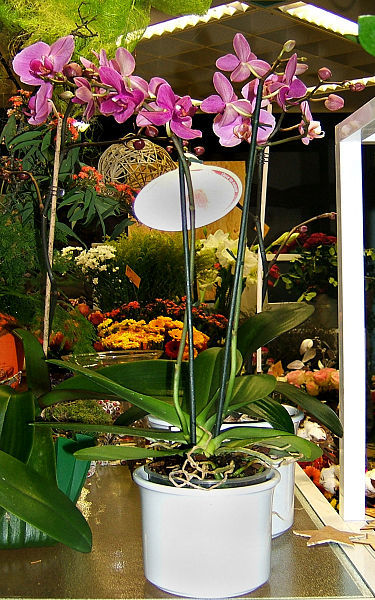Orchids are the plants of wild, difficult to understand. But once you get to know their simple needs, not only do they grow happily they also become addictive. You can grow them outdoors or as houseplants. In both areas the requirements differ somewhat. The plants growing outside in your garden are at the mercy of the prevalent climatic conditions, while those growing inside live in a controlled atmosphere.
If you are planning to grow orchids indoor, then there are few things you need to keep in mind. First and foremost, choosing the right plant is an important decision. Try picking up those orchids which prefer filtered/partial sunlight. In this case orchids like Cymbidiums, Dendrobes, Moth Orchids, Paphs, Phaius tankervilleae will fare well indoors. Avoid orchids which like to grow in open areas, this includes many terrestrials.
For maintaining the orchids inside, you still need to keep an eye on their water, air, light and temperature requirements. These parameters change slightly when you shift them inside. Watering has to be reduced. The evaporation here is at a slower pace, though the air is drier inside. So try keeping the pots in a dish containing water, you can add decorative pebbles to it. The water from the dish will evaporate and create a humid environment in the tiny area around the plant. Watering frequency should follow a simple rule of keeping the roots moist and not wet. It is quite okay for epiphytic orchids to be left dry for short periods of time.
Air circulation does not need much attention outside, but not so in case of indoors. Houseplants need to be kept in an area where there is better air circulation. This can be done either by use fans (ceiling fan are the best option) or by placing the plant near a window or a door.
The best sunlight hours for the orchids are the mornings. So place it near an east facing window/door, even south side is fine. But avoid west window or midday sun, as the strong rays can burn the orchid leaves. The house orchids should be exposed to light periods similar to the day light hours, as orchids will not flower if it gets prolong light periods.
Temperature can be better controlled for houseplants. You can easily protect your plants from extreme cold. Extreme hot temperature do not harm orchids, it becomes lethal only when accompanied by low humidity. They can tolerate temperatures within 18 - 30°C, though orchids grow well in warm to hot climates, so maintaining the temperature around 25 ± 2 °C will promote good growth.
Fertilization can be done once in a month. When purchasing your orchid, inquire about the fertilizer (i.e., the best option out of all different combinations available in your locality) as well as the amount and frequency of application. While fertilizing you also need to take into consideration the type of growth medium being used. If you are using media such as moss, bark etc., which decompose over time and then you need to supply lesser amount of nitrogen.
Keep an eye for pests and diseases, they spread faster indoors. Good luck and happy growing. For comments and queries please use our Orchid Forum or the email option given below.
 Orchid plant (Phalaenopsis) in flower shop in Advent, Germany.
Photography credit: Wildfeuer
Orchid plant (Phalaenopsis) in flower shop in Advent, Germany.
Photography credit: Wildfeuer
Growing Orchids as Houseplants
Beginners Cultureby Anu Dharmani
Originally published in BellaOnline
Posted by Sys Admin almost 9 years ago.Article Blog Article Index
Share on Social Media:
New Topics
- David George asked question Odom's Fascination - an unusual orchid in category General Discussion
- Carol Holdren asked question Grow Tent in the Garage in category General Discussion
- David George asked question rlc Caotan Beauty found at Home Depot in category Cattleya Alliance
- Kristin Dorris asked question Odontocidium Orchid fungus? in category General Discussion
- Maria Fernandez asked question Wild. Lisa Devos in category Dendrobiums
New Comments
- Carol Holdren commented on topic "rlc Caotan Beauty found at Home Depot " by David George
- Carol Holdren commented on topic "Odom's Fascination - an unusual orchid" by David George
- Dr. Florian Wolf commented on topic "Wild. Lisa Devos" by Maria Fernandez
- Michael Valcarcel commented on member plant Rlc. Chief Takanaka by Walceli Muniz Valverde
- Michael Valcarcel commented on member plant Rlc. Montana Spirit by Michael Valcarcel
- Michael Valcarcel commented on member plant Ctt. Blazing Sun by Michael Valcarcel
- Michael Valcarcel commented on member plant Bc. Spotted Clown by Michael Valcarcel
- Maria Skrypnyk commented on member plant Yamadara Redland Sunset by Maria Skrypnyk
- André Pessina commented on topic "Odontocidium Orchid fungus?" by Kristin Dorris
- Linda Hartman commented on topic "Image of a plant please" by Leshya Perkins
- Paul Reavis commented on orchid Milt. Kismet
- Christiaan Viljoen commented on member plant Psh. fragrans by Christiaan Viljoen
- Christiaan Viljoen commented on member plant Z. maculatum by Christiaan Viljoen
- Christiaan Viljoen commented on member plant C. Gaskell-Pumila 'Azure Star' by Christiaan Viljoen
- Robert H. Findlay commented on member plant Rlc. Joy Sokabe var. Volcano Queen by Sally K
- James Lunsford commented on member plant Lc. Sagarik Wax 'African Beauty AMO/AOS x Blc. Cherry Suisse'Kauai' HCC/AOS var. Cattlyea 'Hybrid ' by James Lunsford
- John Varigos commented on orchid Bulb. schwarzii
- Linda Hartman commented on topic "Issue with Blc. Ben O'Neil "Jubilee" by Glenda Ratliff
- Henry Shaw commented on member plant Ons. Catatante 'Los Roble' by Henry Shaw
- Mary Lane commented on member plant Den. Tianmu Canary by Terre Moore